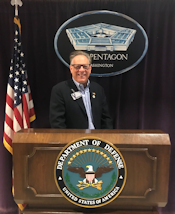NanoBusiness Interview Series – Andrew Maynard, Ph.D.
Posted on February 17th, 2012 in Uncategorized | No Comments »
I have known Andrew Maynard for over 10 years. We have agreed and disagreed on various EHS issues concerning the Nanotechnology Community during our relationship. Even though we have disagreed from time to time I have always found his opinions valuable and thought provoking.
Andrew previously co-chaired the NNI’s Nanotechnology Health and Environment Implications group while working at the National Institute for Occupational Safety and Health. He then became Chief Science Advisor to the Woodrow Wilson Center’s Project on Emerging Nanotechnologies and a frequent spokesperson for PEN’s EHS concerns. He has served on numerous government advisory councils in the U.S. and Canada, including the panels that developed the National Academies report on nanoEHS in 2009 and the draft NRC EHS Research Strategy I discussed in last week’s newsletter.
Today’s interview was written by one of the original Nanotechnology writers, Howard Lovy. The other contributor for today’s interview is Phil Lippel, Ph.D., NanoBusiness Board Member. The opinions expressed by Andrew Maynard are his opinions and this interview is intended to continue our policy of providing all viewpoints in the Nanotechnology Community.
NanoBusiness Interview – Andrew Maynard, Ph.D.
When Andrew Maynard, director of the Risk Science Center at the University of Michigan, read the text of a recent lawsuit by consumer advocates against the U.S. Food and Drug Administration, which claims the FDA is failing to regulate nanomaterials in products, one phrase jumped out at him. The groups used the words “fundamentally unique properties” when referring to nanoscale ingredients.
The phrase, in fact, comes directly from marketing material of the National Nanotechnology Initiative. So, in one sense, the nanotech industry is a victim of its own public relations, Maynard believes. A phrase used to promote nanotech commercialization is being thrown back at nanotech advocates by those who would use the same logic to demand strict regulations.
“There is an assumption that you can have everything your own way,” Maynard says. “You can say something was unique and important and world-changing, selling the hype, and yet not really understanding what the long-term consequences of that hype are.”
This is what Maynard does for a living. He tries to reach beyond hype and beyond gloom to assess and communicate the real risks associated with emerging technologies, including nanotechnology. But he approaches these assessments from a starting point that seems increasingly difficult to achieve in these polarized political times – one based on scientific principles rather than political agenda.
The problem with that “unique properties” phrase that has been so misused over the years is that the science does not necessarily back it up. Material at the nanoscale is not necessarily any different from its macroscale cousin.
“Now, with the research that’s been generated in the last few years, it’s become increasingly clear that there’s no well-defined set of materials that raise red flags when it comes to size,” Maynard says. “About the best you can do is say that the smaller and more sophisticated you make things the more you have to think about a wide range of questions when you’re evaluating safety.”
So, when Maynard now discusses nanotechnology and potential risk, he’s not likely to even use the “n” word. He’s talking about advanced materials, or “sophisticated materials.”
For example, he says, what questions do you ask when trying to determine whether quantum dots are safe? Well, you talk about the composition of the quantum dot, how its physical and chemical structure determines how it interacts with biological systems, and how its size effects where it goes in the body and how it interacts within it.
“But those are not nano-specific questions,” he says. “They’re the questions associated with a specifically designed material.”
The same thing with titanium dioxide found in sunscreens. Shrink them down to nanosize and you get concerns raised by advocacy groups such as the Friends of the Earth and others involved in the lawsuit against the FDA, but the research says titanium dioxide, even at that size, is still pretty benign.
It has taken Maynard a few years to reach this point in his thinking about nanotech. Many in the nanotech business community might remember Maynard when he was scientific adviser for the Wilson Center’s Project on Emerging Nanotechnologies (PEN) between 2005 and 2008. The PEN raised many questions about the potential risks of nanomaterials. Has he changed since his Wilson Center days?
“I have, which is I think inevitable. If you take a young field, our knowledge is going to change over time,” Maynard says. “And if we don’t change our opinions based on that knowledge there’s something wrong.”
But one thing that has not changed is his belief that if nanotech is going to develop into a sustainable industry that is economically robust, it needs to also be “socially robust” and develop with an eye toward social implications.
“It makes a lot of business sense, if you’re developing any new technology – not just nanotech or whatever – to be aware of the possiblities of what might go wrong with that technology and those products and shore things up as early as possible,” he says.
The problem, though, is that roughly 10 years after these questions were first asked, after the U.S. government has invested millions in looking at the environmental and health implications of nanotechnology, we still are not much wiser.
“We know a lot more now,” Maynard says. “The question is do we know a lot more that’s useful now. That’s what I would debate.” The problem, he says, is that the wrong questions are being asked.
Take, for example, carbon nanotubes. There is an assumption by many researchers, Maynard said, that the material is similar to asbestos. But nanotubes are not straight, long, rigid fibers, yet this assumption is driving the research.
“I am quite often concerned that you talk to toxicology groups doing research on carbon nanotubes, I don’t think many of them could actually accurately describe to you the physical form or nature of a carbon nanotube. And yet they’re doing research under various assumptions of what these things are like.”
So, this is the mission of Maynard’s Risk Science Center – to start discussions about the risks of technology with a grounding in real science and not on speculation, taking and “evidence-based approach.”
He’s come a long way since the early 1990s, Maynard, now 46, worked on his Ph. D. at Cambridge in the UK, using advanced microscopy techniques to analyze airborne particles. At the time, many of his colleagues told him he was wasting his time. There would be no future in tiny materials. They were wrong, of course, and Maynard got involved further and further into studying emerging technologies. Eventually, he made the jump from doing science to studying the proper ways of communicating it to the public.
Next on his agenda is looking at issues involved in advanced manufacturing, which overlaps with nanotech. Again, he said he is asking questions having to do with how businesses using new manufacturing technologies, producing new materials, can predict where economic and social barriers are going to be and have a plan to get over them. That includes codes of conduct, standards and best practices. It is up to the industry, itself, to make sure these are in place. The alternative is unwanted regulation.
The most-important advice Maynard gives to the nanotech business community is to simply be aware of the possible implications of the technology they’re developing and make sure regulatory agencies are properly informed of what is being done. But there is no need to respond to individual challenges such as this lawsuit against the FDA.
“It’s worthwhile playing the long game and not being too reactionary to what happens,” Maynard says. “What’s happened over the last 10 years is that concerns over nanotechnology really haven’t gained that much traction.”
In fact, it’s just the opposite. People, in general, remain excited about the prospects of nanotechnology.
“I think the bottom line is to be as honest as possible, and talk to people,” Maynard says. “One of the biggest problems is if you come across as trying to hide things or trying to obscure things. Generally, people are really excited about this technology. They just want to know what’s going on. They want to know what it’s about.”
I hope you have enjoyed this interview. We look forward to continuing our EHS discussions at the Nanotech Commercialization Conference http://www.nanoevent.org/ April 4-5 in Research Triangle – Durham, NC.
Regards,
Vincent Caprio “Serving the Nanotechnology Community for Over a Decade”
Executive Director
NanoBusiness Commercialization Association
203-733-1949
vincent@nanobca.org
www.nanobca.org
www.vincentcaprio.org




